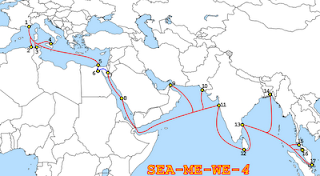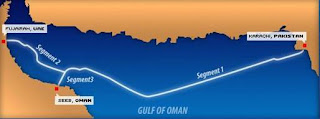PakAlumni Worldwide: The Global Social Network
The Global Social Network
Pakistan's Internet Outage--Service Disrupted Yet Again

Internet and telephone traffic between Europe and the Middle East and Asia has been seriously disrupted since Friday when three major underwater data lines were cut in the Mediterranean, according to media reports.
The main damage is to the four submarine cables running across the Mediterranean and through the Suez Canal. The damaged cables include Sea Me We 4 and Sea Me We 3 lines, which connect countries between Singapore and France as well as the Flag FEA cable route, which stretches from the U.K. to Japan, a France Telecom spokeswoman told Network World. A fault was also reported on the GO submarine cable 130km off Sicily.
France Telecom isn't sure what caused the cut, she said. "We have two assumptions. The first is that it could be an underwater earthquake," she said. "Or it could be simply a ship in the area which has cut the cable." The BBC says that some seismic activity was reported near Malta, where the break apparently occurred, shortly before the cut was detected Friday morning. Ships dragging anchors are also known to have cut submarine cables in the past.
The telecom company listed 14 countries affected by the current problem. The Maldives are 100 percent down, followed by India, which has 82 percent disruption. Qatar, Djibouti and the United Arab Emirates were the next most widely affected areas with about 70 percent service interrupted. Disruptions for Saudi Arabia, Egypt and Pakistan range from 51 percent to 55 percent. It should be noted that the Internet penetration in Pakistan is about 10% versus 5% Internet penetration in India, according to ITU.
Here are the details of impact from outages reported by France Telecom:
* Saudi Arabia: 55% out of service
* Djibouti: 71% out of service
* Egypt: 52% out of service
* United Arab Emirates: 68% out of service
* India: 82% out of service
* Lebanon: 16% out of service
* Malaysia: 42% out of service
* Maldives: 100% out of service
* Pakistan: 51% out of service
* Qatar: 73% out of service
* Syria: 36% out of service
* Taiwan: 39% out of service
* Yemen: 38% out of service
* Zambia: 62% out of service
Pakistani blogger Masud Reza is reporting that PTCL ITI (Information Technology Infrastructure) is running at 25% reduced capacity. Internet users are experiencing high latency and a degraded service level resulting in extremely low speed on downloads.

TW1 also has the same issue. TW1 (Tansworld 1) relies mainly on the SMW4 western segment.
The impact of the cable cuts is being felt much more in India than its neighbors. For example, 82 percent of India's voice traffic capability to Europe was out of service early Friday, although that situation has now improved, according to reports.
A maintenance boat is en route to the site of the cut, but it will not get there until Monday, and it will take as many as two weeks for the situation to return to normal, according to France Telecom.
This is the second time this year that the Internet services have been disrupted in parts of the Middle East and Asia after damage to undersea cables in the Mediterranean. In January 2008, there was disruption to 70% of the nationwide network in Egypt, a government official told Reuters. There was also disruption in the United Arab Emirates (UAE), Kuwait and Saudi Arabia. India also suffered up to 60% disruption, a national industry body told Reuters news agency in January of this year. Pakistan was affected with TW1 customers suffering the most. PTCL switched its Internet traffic from SMW4 to SMW3.
Jonathan Wright - director of wholesale products at Interoute which manages part of the optical fibre network - told the BBC that the effects of the break would be felt for many days.
"This will grind economies to a halt for a short space of time," he told BBC "If you look at, say, local financial markets who trade with European and US markets, the speed at which they get live data will be compromised."
"If you think how quickly trades can be placed, if they are suffering from bad latency times, then by the time a trade is placed, the market may well have moved on."
"We've lost three out of four lines. If the fourth cable breaks, we're looking at a total blackout in the Middle East," said Mr Wright, according to BBC report.
"These three circuits account for 90% of the traffic and we're going to see more international phone calls dropping and a huge degradation in the quality of local internet," he added.
"Normally you would expect to see one major break per cable per year. With four you should have an insurance policy. For this to happen twice in one year, on the same cable, is a serious cause for concern."
A second subsea cable to Malta is currently being laid.
More redundancy, multiple routes and better undersea cable protection should be explored to prevent the continuing negative impact of the repeat damage to the undersea cables.
Twitter Feed
Live Traffic Feed
Sponsored Links
South Asia Investor Review
Investor Information Blog
Haq's Musings
Riaz Haq's Current Affairs Blog
Please Bookmark This Page!
Blog Posts
WIR 2026: Income and Wealth Inequality in India, Pakistan and the World
The top 1% of Indians own 40.1% of the nation's wealth, higher than the 37% global average. This makes India one of the world's most unequal countries, according to the World Inequality Report. By contrast, the top 1% own 24% of the country's wealth in Pakistan, and 23.9% in Bangladesh. Tiny groups of wealthy elites (top 1%) are using their money to buy mass media to manipulate public opinion for their own benefit. They are paying politicians for highly favorable laws and policies to further…
ContinuePosted by Riaz Haq on December 15, 2025 at 1:00pm — 2 Comments
Pakistan Gets its First AI Data Center
Data Vault and Telenor Pakistan have launched the nation's first dedicated AI data center in Karachi. It is designed to support startups, researchers, and government agencies with high-performance computing and GPU-as-a-service offerings. It is equipped with more than 3,000 Nvidia's highest performance H100 and H200 GPUs for which the Trump Administration issued export licenses. These GPUs cost from $40,000 to $60,000 each, making the Nvidia chips the biggest chunk of the investment…
ContinuePosted by Riaz Haq on December 10, 2025 at 11:00am — 2 Comments
© 2025 Created by Riaz Haq.
Powered by
![]()
You need to be a member of PakAlumni Worldwide: The Global Social Network to add comments!
Join PakAlumni Worldwide: The Global Social Network